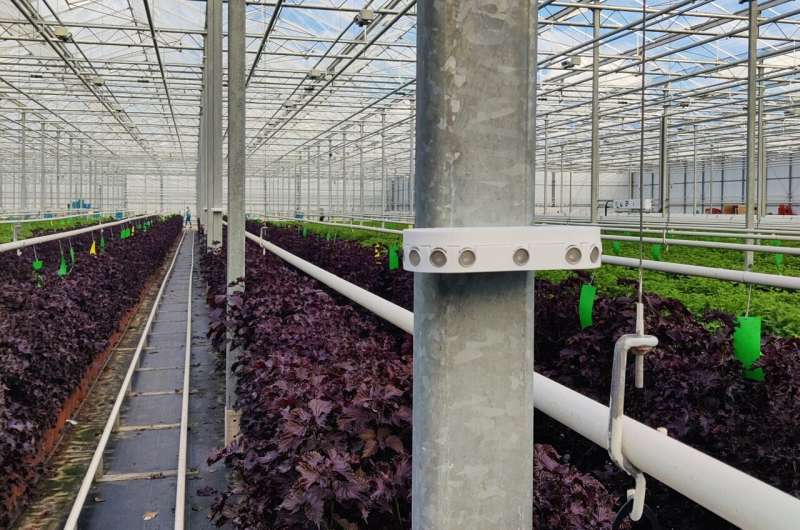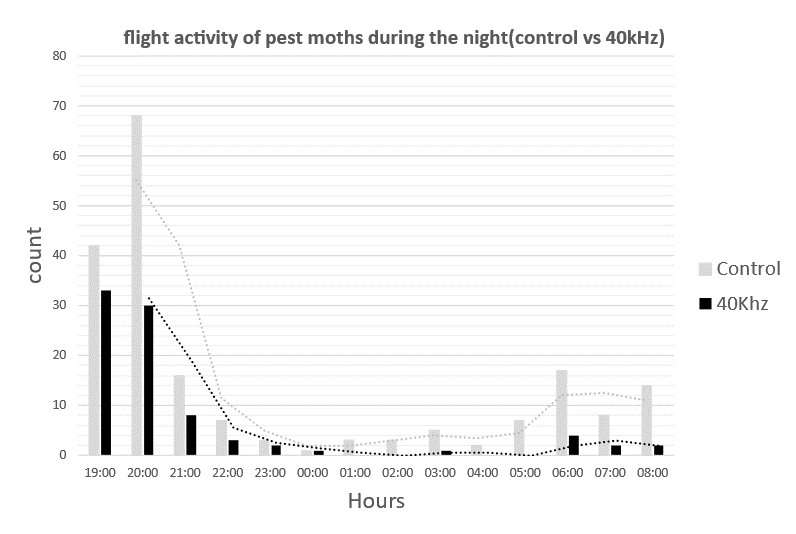
Researchers have been testing real-life Batman-style gadgets to eradicate moth pests from greenhouses, including bat-inspired flying drones that hunt down and destroy moths—but new research reveals that the noise from drones can alter moth flight behavior. Their research was presented at the SEB Centenary Conference 2023, held 4–7 July, in Edinburgh, UK.
“The idea of using drones as an alternative solution to eliminating moths all started in the bedroom of one of the co-owners of the PATS startup company,” says Dayo Jansen, a Ph.D. student from student from Wageningen University and Research in the Netherlands. “He was fed up with all the mosquitoes keeping him awake and he made a drone that hunts down mosquitoes.”
Building on this idea, PATS is now creating drones and other animal-inspired technology to eradicate moth pests from large-scale plant and crop greenhouses.
While the drones are effective at removing moths, new research by Mr. Jansen shows that the noise of their flight affects the moth’s flying behaviors. “After analyzing the sounds, we found that it produces ultrasound in the same range as a bat would be, the moth’s natural predator,” says Mr. Jansen. “Some moths still ignore the noise and get eliminated quickly, but for the moths that do get scared, we doubled down on the sound with our speakers by creating an environment where some of the moths would cease to fly.”
To detect when a moth is flying in the greenhouse, Mr. Jansen uses an infrared camera that can differentiate the moths from other flying insects based on wingbeat frequency and size. “This makes sure we only attack moths and not the bumblebees that are used for pollination,” he says. “The moment a moth flies into detection range, a drone will spin up and hunt the moth down.”
However, several moth species behave quite erratically in response to the drones. “I study these erratic responses and try to find ways to predict the moth’s actions in the future and let the drone move where the moth is bound to go,” says Mr. Jansen.
Part of this research involves playing ultrasonic noises through speakers to influence the moth’s flight behavior. “We find out what sound each moth species is most scared of, making them cease their flight as a whole,” says Mr. Jansen. “We do this firstly by figuring out which bat hunts the moth species that we want to tackle and secondly, study the tympanic hearing organ of the moths to find the sounds that they’re most sensitive to.”
During the experimental setup, when a moth enters the camera’s vision, the speaker plays bursts of ultrasound and the moth’s flight behavior is tracked—this was repeated 850 times. The behavior of the moths was then compared to control setups where the speakers would not play ultrasound after detecting the moths.

They found that the moth behaviors fell into an array of categories, from which diving to the ground was found to be most common, causing the moths to erratically fly into the crops instead of finding a partner for reproduction. “For certain moth species we found that this has the effect of them not even flying anymore and therefore quickly diminishing their flight activity in our systems,” explains Mr. Jansen.
“It has become increasingly difficult to counter agricultural pests,” says Mr. Jansen. “Due to climate change, newer pest species are being introduced in previously inhabitable areas, and monoculture has become a standard in a lot of greenhouses. Greenhouse owners tend to specialize on a singular crop which has the added risk that when a suitable pest species enters the greenhouse, it finds itself in pest heaven and reproduces uncontrollably fast.”
The current way of dealing with greenhouse pest infestation is often to use a tremendous number of unsustainable pesticides, but these systems hope to drive development towards futuristic and bio-inspired solutions that make pesticides a thing of the past.
Currently, the camera vision recognition system (PATS-C) is available and currently active in around 250 greenhouses across Europe. The bat-inspired drone hunting system (PATS-X) is being trialed with first customers and is to be released by the end of 2023.
“With my research we aim to dive deep into some of the most common and harmful species in the European greenhouses and make sure our systems are ready for a tailored approach against them,” concludes Mr. Jansen. “We hope to illustrate the positive effect that comes from bridging the gap between biologists, engineers and industry.”
Provided by
Society for Experimental Biology
Citation:
Exterminating greenhouse pests with bat-inspired drones (2023, July 5)
retrieved 5 July 2023
from https://phys.org/news/2023-07-exterminating-greenhouse-pests-bat-inspired-drones.html
This document is subject to copyright. Apart from any fair dealing for the purpose of private study or research, no
part may be reproduced without the written permission. The content is provided for information purposes only.









